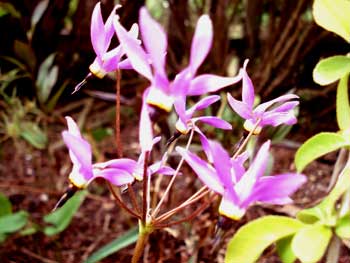
Darkthroat Shooting Star
aka, Western Shooting Star
American Cowslip
Few-leaved Shooting Star
Few-flowered Shooting Star
Prairie Shooting Star
or, Pretty Shooting Star
"In all things of nature there is something marvelous. "
-Aristotle
I can't believe all the photos I took of the Western Shooting Star (Dodecatheon pulchellum) came out so rotten. This was the best of a washed-out lot. By the time I downloaded the snapshots, it was too late for another try. I'll try to do better next spring.It has a number of common names throughout its extensive range in western North America, including Darkthroat Shooting Star, American Cowslip, Few-leaved Shooting Star, Prairie Shooting Star, or Pretty Shooting Star.
To some degree it's good think of this perennial herb as a spring bulb. It's not a bulb of course but as an ephemeral it goes dormant in summer & will not be seen until the following spring.
The strap-shaped leaves are unassuming, few, & remain close to the ground. But those blooms! It has bright lavender-pink or fuchsia spaceship-flowers, arranged loosely atop a ten to eighteen inch leafless wiry stem. The petals are strongly reflexed to the rear, & five anthers are joined into a point at the front, so it really does look like a rocket ship or a comet.
The fact that these blooms face downward further heightens the sense that they are meteors catching fire in the Earth's atmosphere, rushing to exterminate the dinosaurs -- or us.
Pacific Northwest native peoples formerly made an eye-wash by boiling shoot star roots. In Northwest longhouses, as in teepees of plains peoples, there was only a smoke-hole in the roof. First peoples did not have chimneys for their firepits. In consequence, their lodges were smokey, & eye irritation was a commonplace, so that any plant that assisted in soothing eyes was bound to be discovered.
Shooting stars can be slow to establish but in time a single start becomes a colonizing clump of many flowering stems.
Hardy down to zone 5, it likes a dampish location. It's very sensitive to droughtiness in spring, but when it goes dormant in summer, it no longer needs watering. Rich soil is best but it's adaptable to poorer soils. Too much direct sun will shorten its season, but too much shade keeps it from blooming, so bright shade or full morning sun or partial afternoon sun does it best.
Since it vanishes utterly when summer-dormant & won't be seen again until spring, it's essential to mark its location carefully, so that it will not be disrupted. And don't mistake the humble first leaves of spring for a weed!
See also the White Shooting Star:
Dodecatheon meadia